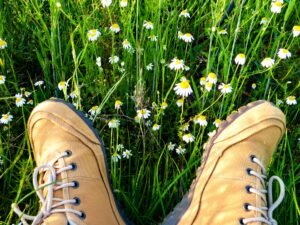
As a recent college graduate in a busy internship and someone who has both generalized anxiety disorder and major depressive disorder, being proactive in taking care of myself is crucial. I’m not always the best at it—especially when life is busy and I don’t have a lot of spare time or energy. However, there’s one practice that continues to be both accessible and beneficial: time spent mindfully outdoors.
Resting in Nature
One afternoon recently, I was feeling low—no energy, emotionally numb, overwhelmed—and, lucky enough to not have a pressing task, I grabbed a picnic blanket and my sunglasses and went outside. Stretched out in the sun, I quickly started to feel just a little bit better. I chose not to listen to music or read a book—much less to do work. Instead, I focused on the soft warmth of the sun on my skin and how the occasional, cool breeze contrasted with it. I relished the earthy smell of the grass. I listened in on the conversations the birds were having in the trees around me. I shut my eyes to the world. By the time I went inside to make dinner, my mood had improved exponentially, I had energy to get a few tasks done, and I spent an enjoyable evening with a couple of close friends.
Walking in Nature
Other days, I like to practice similar mindfulness habits but while walking. Nature-based meditation might seem overly simple, but it’s a consistently useful and joy-inducing activity for me. It’s also free and can be done in as little or as much time as I have available. Below are few ideas for how to spend time outdoors mindfully:
- Pick a color. Then go for a walk and look for everything of that color. Sometimes more broad suggestions to be “observant” are unhelpfully vague. Looking for color, can give your mind a specific task to meditate upon.
- Walk slowly. Personally, I tend to walk quickly no matter where I’m going or how much I’m in a hurry. So when I slow down, or even sit down, it feels luxurious and thoughtful. This guides me into a meditative mindset.
- Count steps. Because my mind wanders easily to worries and to-do list items, I like to count my steps up to 10 or 20 over and over. This gives my mind something to focus on and the repetition of counting can be soothing.
- Pay attention to your feet. If you’re walking, think about the way your feet feel coming off and onto the ground. If you’re sitting, notice how you’re sitting. Are your feet flat on the ground? Are your shoes loose or tight?
- Breathe deeply. This is a common mindfulness recommendation for obvious reasons—it’s calming and grounding. However, breathing thoughtfully can also double as a way to stay focused on the smell of the air around you. Is it fresh? Grassy? Humid? The outdoors often smells so lovely.
Find Out More
These are a few suggestions that help make outdoor mindfulness most accessible for me. How To Walk by Thich Nhat Hanh is another great resource for learning about mindful walking. You can find more scientific information on the benefits of the outdoors, mindfulness, and walking, in these articles: Spending at least 120 minutes a week in nature is associated with good health and wellbeing and Experimental effects of brief, single bouts of walking and meditation on mood profile in young adults.
On some days, I only have a few minutes, but it’s still worth it to get outside and ground myself in the outdoor world. It changes my perspective on life—whatever is stressing me out or making me anxious feels a little more manageable when I remind myself how beautiful the natural world is. As I’m writing this, I’m sitting in the shade outside a cafe and I have a lot of work to do. But people are laughing and coming and going and the breeze is in my hair and the sun is out with vigor. I am calm and at peace.










